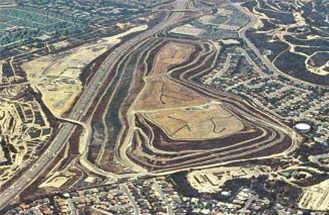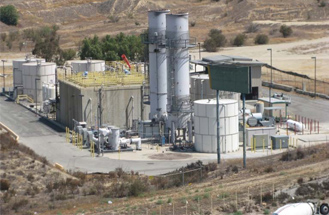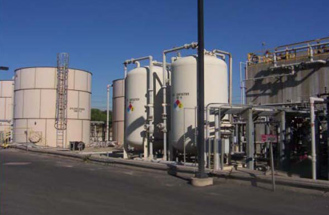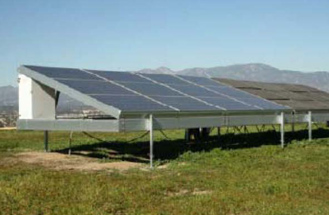Green Remediation Focus
Operating Industries, Inc. Landfill
Monterey Park, California
Superfund NPL
Cleanup Objectives: Remediate soil and groundwater contaminated by a 190-acre inactive landfill.
Green Remediation Strategy: (1) Install a RCRA-compliant landfill cover with an alternative design intended to mimic the area's ecology and control moisture infiltration; (2) capture landfill gas (LFG) and convert it to useable energy for onsite use in removing volatile organic compounds (VOCs) and other contaminants from the landfill emissions; (3) develop onsite sources of renewable energy to offset energy needs of ongoing cleanup while potentially supporting the infrastructure of future site use; and (4) integrate best management practices into general site operation, maintenance and monitoring, with a focus on energy- and water-efficiency and waste recycling. Key activities have included:
- Installing an evapotranspiration (ET) cover with native vegetation to limit rainwater percolation into the underlying waste material and LFG escape into ambient air. During construction, soil was keyed into geogrid layers placed at five-meter intervals along the cover's steep side slopes to minimize erosion, soil creep, and gully development while maximizing stability during seismic disturbances.
- Operating six 70-kW microturbines for approximately seven years (2002 to 2010) to produce electricity from LFG collected through 481 gas extraction wells (including 185 dual-phase extraction wells) rather than continuing to manage the LFG exclusively as waste via flaring. The microturbines were shut down when LFG methane content diminished and the associated need for equipment upgrades no longer supported their operation economically.
- Providing site access to an energy development consultant in 2012-2014 for conducting a 12-month solar pilot test funded by the California Energy Commission to assess the potential for electricity generation and impacts on landfill cover stability, such as additional soil/waste settlement or vegetation impairment. The pilot-scale system involved temporary placement of a fixed-tilt, 2,820-watt array of 12 self-ballasted racked photovoltaic (PV) panels weighing 2,000 pounds, as well as two weight- and shading-simulation units on the top deck of the landfill.
- Continuing exploration of other green and cost-effective power generation options and periodically reassessing opportunities to optimize groundwater sampling.
Results:
ET Cover
- Minimizing the need for irrigation due to the ability of native vegetation selected for the landfill cover to grow and survive in the local climate.
- Minimizing percolation into the landfill's covered waste, which is confirmed through periodic inspections and continuous maintenance of the landfill cover, access roads, and stormwater collection system.
- Preventing release of LFG exceeding regulatory limits, as verified by periodic gas emission surveillance on the entire landfill cover.
- Preventing the need for application of chemical fungicides, herbicides or pesticides through use of integrated pest management techniques for ET cover maintenance.
LFG Energy System
- Extracted LFG with a methane content ranging from 29 to 47% at an average rate of 4,200 standard cubic feet per minute for conversion to electricity through 2010.
- Generated sufficient electricity from LFG during microturbine operations to meet approximately 80% of the annual energy demand of the landfill leachate treatment plant (LTP).
- Prevented the need for additional emission controls for VOCs by returning microturbine emissions to the LFG treatment system.
- Recovered nearly 45% of the $1.25 million microturbine purchasing costs (including equipment, installation, and warranty) through receipt of a $450,000 energy grant from Southern California Edison and a $105,000 energy rebate from the California Energy Commission.
- Generated more than 15,000 MWh of electricity over seven years of operation, resulting in an energy cost savings of nearly $21,000 for the project each month (approximately $1.75 million total).
- Offset $300,000 to $400,000 in annual electricity costs incurred for operating the existing LFG treatment system that uses energy-intensive combustion blowers, thermal oxidizers operating at 1,800°F, and auxiliary equipment with a total power load of 300 kW.
- Derived a cumulative net project savings conservatively estimated at $647,000 over seven years of microturbine operations, based on 2006/2007 energy production rates. These savings reflected an annual cost of $25,000 for microturbine operation, following an initial five-year equipment warranty period during which annual operating costs averaged $10,000.
Solar Energy Development
- Demonstrated that a solar racking system can provide a feasible renewable energy source at this site, based on pilot study findings that (1) the PV system generated an annual average power of 2-2.8 kW, as anticipated; and (2) the presence of the PV racks did not significantly affect landfill cover integrity, as indicated by low (0.6 millimeter) cover displacement after one year, no cap penetration due to the solar racking system weight, and minimal effect on vegetation growth (with only slight impairment of vegetation growth in areas under the racks, potentially due to increased shading and decreased exposure to precipitation).
Operation, Maintenance and Monitoring
- Reducing burden on the local landfill and promoting beneficial reuse of materials through recycling of (1) all concrete and metal waste found or generated onsite, including access roads; (2) all routine waste such as aluminum, plastic, cardboard, paper and oil; and (3) cuttings removed during cover maintenance by sending them to a local composter.
- Reducing fuel consumption through use of portable containers (Conex boxes) to store equipment and materials for daily operations and maintenance of the landfill, rather than frequently transporting equipment/materials across the site.
- Reducing demand on the electrical grid through use of standalone solar panels to power weather stations and lighting on the covered landfill's top deck.
- Reducing electricity consumption through installation of energy-efficient interior lighting for the site office and use of movement sensors for outside lighting systems.
- Reducing frequency of field visits and associated fuel consumption and air emissions through use of automated electronic technology to collect and transmit data (via WiFi) from extraction wells.
- Decreasing water consumption through use of stormwater collected in the LTP containment area for irrigation, when needed, and to back-flush the leachate extraction lines.
Property End Use: Commercial/industrial operations or open space, pending Superfund close-out.
Point of Contact: Julie Santiago-Ocasio, U.S. EPA Region 9
Update: December 2014















